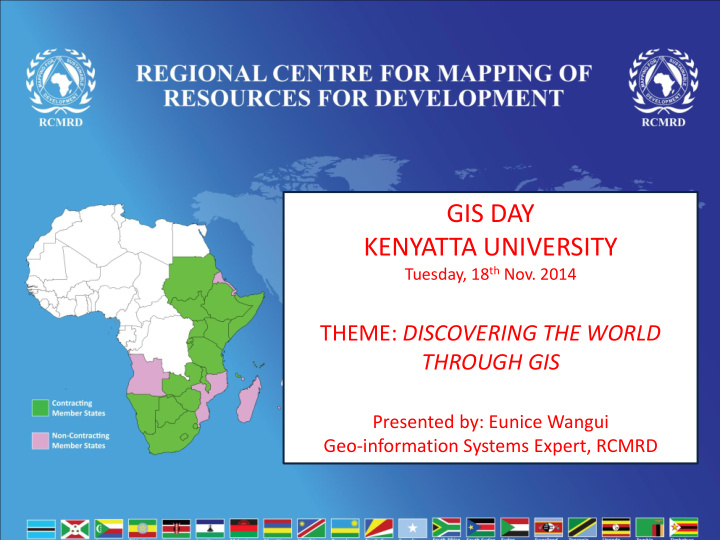



GIS DAY KENYATTA UNIVERSITY Tuesday, 18 th Nov. 2014 THEME: DISCOVERING THE WORLD THROUGH GIS Presented by: Eunice Wangui Geo-information Systems Expert, RCMRD
Who we are? • RCMRD established in 1975 under UNECA and OAU • Inter-governmental organization with 20 Contracting Member States in Eastern and Southern Africa Regions Mission: To promote sustainable development through generation, application and dissemination of Geo-Information and allied ICT services and products in the Member States and beyond.
How we do it? • Approach: RCMRD functional programmes have moved away from – service technology framework (e.g. Remote Sensing, Geodesy, Cartography etc.) to – problem solving applications in natural resource and environmental management. – RCMRD is now providing service on demand driven basis. • Vision: To be a Premier Centre of Excellence in Provision of Geo-Information Services
What we do? • Projects: MESA: • Aims at promoting the use of Earth observation monitoring technologies in support of development of policies in the management of African environment and for sustainable development of natural resources. Objective: • establish operational information services to – assess land degradation – monitor land cover changes in natural habitats – Manage forest Information management System to improve policy and decision making process in the IGAD region. And to identify local hotspots for comprehensive assessment
• Servir : Goal is to improve environmental management and resilience to climate change. • Provides geospatial applications, services, and capacity building for sharing, integrating, mapping, and forecasting using different kinds of geo-information from different sources • Eg. Interactive mapper:
• GHG Project : RCMRD has been at the forefront of developing LULC maps for GHG inventory for Malawi, Rwanda, Zambia, Namibia, Botswana and Tanzania in the reporting year. For the year 2014, the Centre will produce maps for Ethiopia, Kenya and Uganda.
• Lake Victoria Water and sanitation project : pro- poor invention designed to address the water and sanitation related MDGs. • Task: develop baseline data and maps for 17 secondary towns, – by means of an up-to-date high-resolution satellite image (QuickBird), inclusive of cadastral, water and sewerage net, waste disposals, water sources, house hold data and spatial community profile record.
Satellite Data Dissemination • RCMRD has installed a new satellite tracking system with access to near real-time data from Earth observation satellites • Google.org funded a direct antenna for NASA's Moderate-resolution Imaging Spectro-radiometer (MODIS) to – help provide better situational awareness for disasters such as floods and wildfires etc
Satellite Data Dissemination Very High Resolution Satellite Imagery
High Resolution Satellites a) SPOT: Spot 2, 3, 5 and 6 (Resolution range between 1.5 – 5 m). First Mission Launched in Early 90’s (multi-spectral) a) Rapid Eye : Resolution 5 m. Launched in 2008 (multi-spectral)
Medium Resolution Satellite Imagery Low Resolution Satellite Imagery
Land Survey: Servicing and Maintenance • Engineering Section of RCMRD does repair , service and calibration of surveying and mapping equipment from member countries
Training • Land management : GPS Course; This course aims to assist participants understand the principles of GPS positioning methods • GIS and Mapping : Introduction to basics and advanced course in GIS/RS • Information technology : Certificate and diploma in I.T
THE END THANK YOU.
Recommend
More recommend